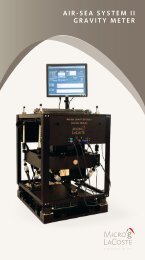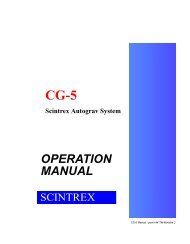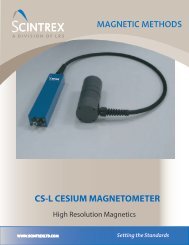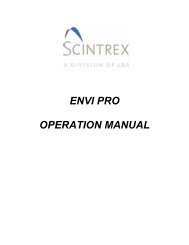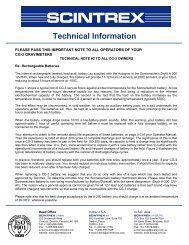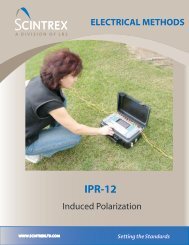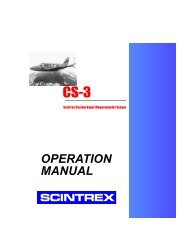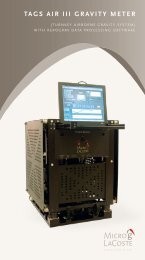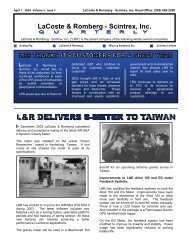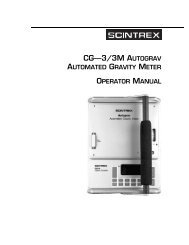CS-L Cesium Vapor Magnetometer Sensor OPERATION ... - Scintrex
CS-L Cesium Vapor Magnetometer Sensor OPERATION ... - Scintrex
CS-L Cesium Vapor Magnetometer Sensor OPERATION ... - Scintrex
You also want an ePaper? Increase the reach of your titles
YUMPU automatically turns print PDFs into web optimized ePapers that Google loves.
Orienting<br />
• the orientation c) for the field inclinations from 0° to 35°<br />
then:<br />
1. the minimum safety margin to the boundary of the operating range is 14°<br />
and it will occur for the field inclination 62°<br />
2. the safety margin less than 15° will occur only for the range of the field<br />
inclinations from 60° to 65°<br />
3. the safety margin less than 20° will occur for the range of the field inclina-<br />
tions from 55° to 78°.<br />
4—17<br />
Note: The additional allowance of 5° has been already<br />
subtracted from the essential operating range specified<br />
by relationships (1) and (2) to arrive to the reduced operating<br />
range, relationships (4) and (5) for which the above analysis<br />
applies.<br />
Comparison with the Locked Oscillator<br />
Optically pumped magnetometers using the locked oscillator principle of operation<br />
exhibit two distinct features as far as the operating range is concerned:<br />
• there is no polar dead zone, only the equatorial dead zone is present<br />
• the magnetometer operates in both magnetic hemispheres of the ambient<br />
field without any adjustment.<br />
Modern self-oscillating magnetometers, like the <strong>CS</strong>-L have overcome the<br />
shortcoming of two operating hemispheres by incorporating an effective<br />
electronic control of the operating hemisphere selection.<br />
The asset of having only one dead zone was claimed to be a valuable<br />
operational advantage "without orientation problems associated with selfoscillating<br />
alkali vapor magnetometers" (e.g. EG&G brochure for the G-833 Helium<br />
<strong>Magnetometer</strong>). The following rigorous analysis will prove that the <strong>CS</strong>-L has superior<br />
orienting capabilities.<br />
The operating range of the locked oscillator extends 65° from the polar orientations<br />
according to the relationships:<br />
0° < q< 65° (4)<br />
and from<br />
115° < q< 180° (5)<br />
It has been experimentally determined by impartial evaluators that inside this<br />
operating zone the magnetometer noise will increase by about a factor of three from<br />
the minimum value at q=0° or q=180°. Passed this range, noise increases rapidly,<br />
e.g. at 70° from the polar orientation the noise is 7-8 times larger than in the polar<br />
orientation.<br />
P/N 763701 Rev. 1



